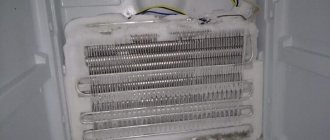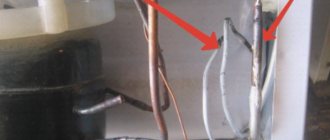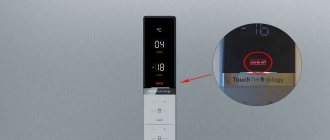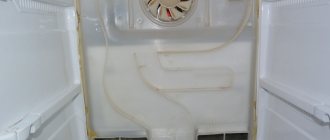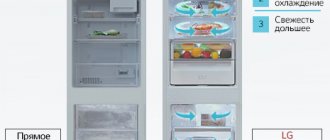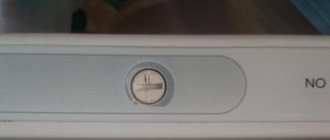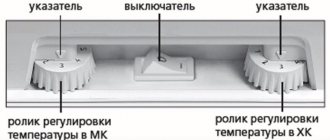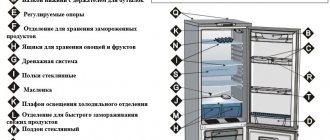Causes and signs of a refrigerant leak
By some signs you can find out how to determine a freon leak:
- The quality of system cooling gradually decreases. The equipment does not freeze well, and the food is poorly refrigerated.
- Continuous operation of the compressor with rare breaks, which is important when there is insufficient cooling.
- The compressor does not start and there is no cooling due to a freon leak in the refrigerator.
- Information about the problem appears on the small screen. Some models have indicators that flash red.
Upon preliminary inspection, you can notice a layer of snow on the evaporator, which appears in a short time. If you can’t figure out what the problem is on your own. It is better to contact specialists who will tell you how to understand that freon has leaked from the refrigerator and will help you get rid of the problem.
Snow on the evaporator
The main reason that freon leaked was non-compliance with certain operating rules:
- inaccurate transportation and unloading causes destruction of the seams;
- using a knife or fork to speed up defrosting can damage the tubes;
- lack of regular defrosting leads to ice accumulation and gradual rusting;
- long service life and corrosion;
- fulfillment of defects at the factory.
If there is little refrigerant, the compressor runs constantly, but the chamber is warm. A technician with a special tool can understand what happened and find the breakdown.
Checking system pressure
If the leak is not eliminated in a timely manner, problems with the functioning of the equipment and subsequent failure may occur. If moisture leaks into the circuit, acid will appear, which will cause corrosion and combustion of the windings in the compressor. A lack of cooling component allows air to enter the system. When refrigerant leaks, oil may also leak. Lack of cooling provokes overheating of the main device and its failure.
All these consequences of a lack of a cooling component greatly reduce the service life of the equipment.
Why do you need freon
Not all people know what function the refrigerant performs. Freon is the main working substance that removes heat from the compartments of the refrigerator. Therefore, the required temperature is maintained in the internal chambers.
If there is not enough gas or it leaks, the equipment stops working normally or fails completely. It is important to be able to detect freon leaks and know through which places it comes out.
To better understand why refrigerant is needed, you can familiarize yourself with the operating principle of a household appliance motor:
- the compressor relay turns on, closing the electrical circuit, when the temperature rises, and when the cold blower operates, the required pressure is created in the system so that the gas enters the condenser radiator;
- the refrigerant becomes liquid and a large amount of heat is generated, dissipating into space thanks to the radiator grille;
- after passing through the evaporator, the substance ends up in the pipeline, where the pressure equalizes and gradually decreases;
- liquid refrigerant enters the radiator and is heated to a predetermined temperature, and then turns into steam;
- The condenser cools and the temperature in the refrigerator decreases.
Some believe that freon is harmful to the human body. However, it only becomes dangerous if there is a large gas leak. There is a small amount of it in the refrigerator. For example, Atlant devices contain 60-135 g of freon. The exact amount of refrigerant depends on the model of household appliance.
View » Why the light in the refrigerator does not light up
How to find a freon leak in a refrigerator yourself at home
The appearance of an unpleasant odor is evidence of refrigerant leakage. Although the freon from the refrigerator does not smell anything, when it evaporates, the microclimate in the device changes, and pathogenic microorganisms are formed that cause the odor. A heavy odor may be caused by a clogged drainage system. In this case, it is enough to clean the capillary tubes. Unpleasant odors also occur when equipment is not properly maintained. If there is a burning smell, most likely the compressor has broken down due to a lack of refrigerant.
Therefore, it is impossible to know exactly what kind of smell freon has, but to identify the problem you need to perform the following steps:
- Monitor the operation of the compressor to note the start time.
- Inspect the tightness of the seal along the contour. You should try pulling a thin strip of paper through the closed door. If this is difficult to do, the seal is fine.
- It is important to check the network. If there is a power failure, there will be no compression.
In such situations, the problem does not arise from a refrigerant leak. You can do simple manipulations at home; if the problem persists, you need to seek professional help.
Search in accessible places
To find leaks in accessible places, specialists use the following methods:
- use a foam solution where oil stains appear;
- use liquid. This method allows you to identify depressurization of removable elements. The device is filled with nitrogen, sealed and lowered into water. Additionally, soap is added;
- A halogen device is used to help detect the leakage of refrigerant containing chlorine. The device is effective in detecting small cracks;
- ultraviolet dyes are poured into the device;
- Punctures can be detected using high pressure. If the pressure is insufficient, filling with dry nitrogen is used. When it leaves the system, you can hear a noise at the crack site;
- Ultrasound diagnostics detect leakage sounds that humans cannot hear. A special device will help if there is pressure in the system.
Soap solution test
Effective methods include a test with a soap solution. It is very easy to make, but can also be purchased in stores. This may be a solution in an aerosol package or a product with added additives or in a set with brushes. After completing the spray application procedure, you must remember to remove its residues, as they contain corrosive active ingredients.
Search in hidden places
Difficulties arise with internal leaks. You can notice the problem by the swollen walls. And to determine hidden leaks, an electronic leak detector is used. This mechanism reveals small cracks.
What does a freon leak look like in a refrigerator?
If refrigerant is leaking, this can be determined by inspection. The breakout area becomes a black spot and oil remains around. If the puncture is in the closed part, the chamber wall will swell.
If freon leaks from the refrigerator, the chamber will be warm and an oily puddle will appear on the floor. When the refrigerant enters the room, it evaporates and leaves behind oil, condensate and decomposition products. The cold grille on the front side is also an indicator.
The specialist knows exactly how to find a freon leak in the refrigerator. For this purpose, there is a special device that sounds a sound signal when a violation of integrity is detected.
Internal freon leak in refrigerator
Difficulties arise if a freon leak occurs inside the device. In such a situation, it is necessary to change the refrigerant circuit. If there is a breakthrough in the door circuit, the tube is laid along the rear surface. If there is a breakthrough in the housing, the specialist removes the insulation and makes the circuit again. It is very difficult to restore the operation of equipment after such a breakdown. And some companies that have a refrigerator under warranty do not repair the equipment, but provide a replacement.
Leak inside refrigerator
How to find a freon leak using an ultraviolet additive
Previously, this technique was used in automobile air conditioning systems, but today it is gradually replacing other methods, which is not surprising considering how much the ultraviolet additive in freon makes it easier to find leaks. The main advantage is maximum ease of diagnosis. In order to find the location of the leak, it is enough to pump a special dye into the circuit, and after it has passed through several circulation circles along with the working composition, inspect all the components of the system using an ultraviolet lamp. This means that anyone can find a freon leak in a refrigerator, car or household air conditioner using an ultraviolet additive, because this method allows you to practically not disassemble the equipment!
In addition, this method is considered the most effective due to the optimal ratio of price and effectiveness, because the cost of purchasing a dye visible in a certain spectrum is incomparable with the cost of full washing and the use of other methods.
It is also worth mentioning that an ultraviolet additive for detecting freon leaks:
- Can be mixed with any type of refrigerant, even CFC, HFC and HCFC;
- Does not contain solvents hazardous to equipment and human health;
- Allows you to determine the location and nature of damage as accurately as possible;
- The best tool for prevention;
- Does not change the operating parameters of the refrigerant.
A separate advantage of the ultraviolet dye for detecting leaks is the absence of difficulties in purchasing a UV lamp for diagnostics - the dyes are visible under any source of such radiation, even a regular LED. In order to minimize the time spent searching for leaks, it is better to inspect the system in the dark and wear UV glasses, but even without them, this method is characterized by the greatest simplicity in detecting fault localization.
Fixing a freon leak in a refrigerator
Various methods are used to restore tightness. Soldering is used to repair damage in the evaporator. Argon welding is used to join aluminum and copper pipes. In some cases, the leak occurs at the junction of the compressor and the fitting, and the circuit may not require repair. To troubleshoot the problem, the specialist performs the following steps:
- Carrying out diagnostics. The technician must understand why freon is leaking from the refrigerator.
- Detection of cracks and punctures in circuit tubes.
- To remove residual refrigerant and condensate, the system is evacuated.
- The circuit is filled with gas in the required volume.
- The technician must check the equipment for leaks.
Repairing Freon Leaks
Even after pumping in freon, the cooling effect may not be fully restored. May need refilling.
Soldering
To eliminate cracks, a soldering method is used, which includes the following manipulations:
- The soldering area is carefully prepared. To do this, insulation is carried out using asbestos gaskets that protect the elements from the burners;
- puncture areas are sealed with solder with a silver base and a special paste;
- dryer filters are being replaced;
- The treated areas are checked for leaks.
If the sealing is done correctly, the specialist proceeds to filling the circuit with freon. Injection is carried out through the Schrader valve. The refrigerant is taken from a special cylinder.
Without repair
In cases where the breakdown is associated with clogged filters or capillary pipes, no repairs are made. To get rid of the problem, just clean it. If liquid has entered the cooling circuit, you will need to remove the filter drier. After fixing the problem, it is necessary to restore the required amount of gas. Refueling should be done by specialists. After refueling, you need to check the functionality of the cameras. If the tubes that enter the circuit begin to freeze, it means that freon has been added in excess.
Excess freon
Leak testing is also performed. If necessary, moisture is removed from the circuit. A vacuum device is used for this.
How to determine what freon is in your refrigerator
Freons consist of a mixture of ethane and methane, in which hydrogen atoms are used instead of chlorine and fluorine atoms. In a refrigerator, the refrigerant evaporates and condenses into a liquid. As a result, cooling occurs. The industry produces more than 40 varieties of freons. But only some of them are used for household appliances.
To find out what kind of freon is in the refrigerator, you need to look at the technical documentation. Here manufacturers indicate the characteristics of the equipment. The type of refrigerant is also indicated on the compressor.
Initially, R 12 freon was used in refrigerators. It was used in the production of models such as Zil and Dnepr. This substance was highly effective, but was banned due to its low environmental friendliness. Among the advantages, it is worth noting the low cost, the ability to replace with other refrigerants and high performance. The disadvantage is the high noise level.
R12 was replaced by R134A or tetrafluoroethane. When this refrigerant is used, the compressors use synthetic oil. This component does not dissolve oil well, as a result of which it is not completely returned to the compressor. This causes blockages in the capillary pipes. Among the advantages, it is worth noting the high cooling capacity. There are also some disadvantages. Freon cannot be replaced with other alternatives.
The new refrigerants include R600A, which is suitable for class A equipment. Equipment running on this freon is characterized by low energy consumption and noise. This was achieved through the use of compressors with reduced power levels. The disadvantages of the refrigerant include the risk of explosion, but this component is so small that it is not dangerous for users. When repairing equipment with such a refrigerant, fire safety regulations must be observed. The advantages include the possibility of replacement with other refrigerants.
Why do you need freon in a refrigerator?
Refrigeration equipment known to most people works with the participation of a compressor. A regular refrigerator looks like a chamber containing an evaporator. The evaporator houses the refrigerant. This is a substance necessary to create cooling. During boiling and evaporation, it takes heat away from the chamber and transfers it to the environment during condensation. The refrigerant then enters the compressor in gaseous form. Then the base goes into a liquid state. This cycle ensures the appearance of coolness and cold in the refrigerator compartment.
Freon is a type of refrigerant. That is, every freon is a refrigerant, but not every refrigerant is freon. Freon is a chemical mixture of ethane and methane. There are different formulas that explain the existence of different types of freons: R-134a, R-12, R-503, etc. Freon is located in the evaporator, where it carries out its functionality. Thanks to freon, the refrigerator is cold.
Where is the highest probability of leaks?
Refilling equipment with freon is not that difficult. But to carry out repairs, it is necessary to correctly determine the location of the leak. To quickly determine the presence of cracks, it is important to know the problem areas in the equipment:
- Pipe soldering areas. The internal contour consists of elements that are joined by soldering. During the production process, joints may be welded poorly. As a result, small cracks appear at the joints, through which coolant slowly flows out.
- An evaporator that is placed inside the equipment. It is made from thin metal. When leaks appear, a layer of frost appears on the surface of the device. After removing it, you can fix the problem. A crack is difficult to repair if it is on the inside.
- Freon circulates in the heating circuit. Gas flows inside the system from the internal chambers and to the compressor. As a result, excess heat is removed. This device is used to eliminate condensation, so corrosion may occur.
Once the leak is detected, the problem can be fixed. If you have the skills, the problem can be fixed on your own. But in order for the work to be done efficiently, it is worth contacting a specialist.
Leak detection using soap solution
Typically, this option is effective in a situation where the expected location of the leak is theoretically known - all that remains is to detect it in practice.
For example, during repair work, during the replacement of a system component - when a specialist obviously suspects the presence of a leak or sees traces of oil contamination. The advantages of this option are the simplicity of the method and its low cost.
The soap solution itself can be easily prepared yourself - using a regular dishwashing sponge and detergent or regular soap.
But in stores they sell a lot of products for this:
- Soap solutions in aerosol packaging.
- With the addition of various auxiliary additives.
- Complete with brushes.
The most famous of them are Rotenberger Rotest and Advanced EasyFind.
In any case, this is a very affordable and simple way to detect the location of a refrigerant leak and can be used in conjunction with nitrogen pressure testing.
There are several rules to consider when using this method:
- If the soap solution is applied using a proprietary spray, then after use it must be removed, as it contains active additives
- If the pressure in the system is insufficient, you can replace the refrigerant with dry nitrogen. This substance, among other things, can create some noise when leaving the system at the leak site, which will facilitate the search procedure.
- Oil stains indirectly indicate leaks, so it is in these cases that a soap solution will be very effective.
